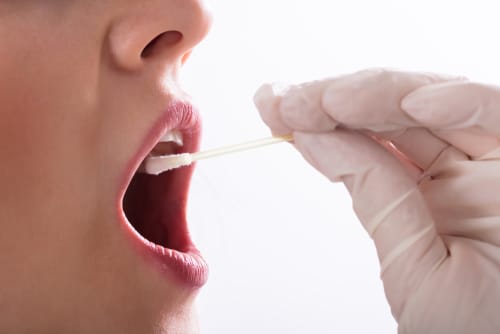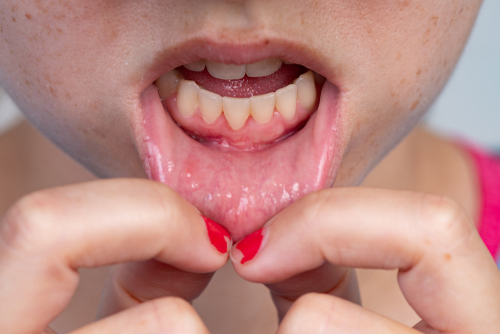
Having a dental emergency? Call us!
614-882-1135
We understand that dental emergencies can happen at any time. If you're in need of urgent care, give us a call, and we'll do everything we can to assist you when it matters most.
Patient Testimonials
Discover Better Dentistry
Become a part of the
Westerville Dental family!
We're accepting new patients. Our dental team prides itself on delivering a truly efficient and enjoyable experience while you’re with us.

Good Oral Health Starts With You. That’s why it’s important to understand the impact of oral health on your overall well-being. One common oral health concern is periodontal disease, also known as gum disease. It affects the tissues surrounding the teeth and can lead to tooth loss if left untreated. But did you know that periodontal disease is not just a dental problem? It has been linked to various systemic health conditions, including cardiovascular disease, diabetes, stroke, and birth complications.
Fortunately, advancements in dental technology have made it possible to detect and treat periodontal disease more effectively. One such advancement is oral DNA testing, a powerful tool that can provide valuable insights into the specific bacteria causing gum infections and inflammation. This type of testing can also help determine the genetic markers associated with increased inflammation and the severity of periodontal disease.
In this blog, we will explore the role of oral DNA testing in diagnosing and treating periodontal disease. We will delve into its benefits, the testing process, recent advancements in technology, and how it compares to traditional diagnostic methods. We will also discuss how oral DNA testing can be implemented in dental practices and share patient stories that highlight the successes of this innovative approach.
Understanding Periodontal Disease
Periodontal disease, also known as gum disease, is a condition characterized by inflammation of the tissues surrounding the teeth. It is primarily caused by specific bacteria present in the mouth. If left untreated, periodontal disease can lead to tooth loss and have negative impacts on oral health. However, recent research has shown that periodontal disease is not confined to the mouth; it can also have significant effects on overall health.
The Basics of Periodontal Disease: Causes and Symptoms
Periodontal disease is primarily caused by specific bacteria and oral pathogens that thrive in the mouth. When these bacteria accumulate and form plaque on the teeth, it can lead to inflammation of the gums. Over time, if not properly treated, the inflammation can progress and result in the breakdown of the tissues supporting the teeth, leading to tooth loss.
Symptoms of periodontal disease may include red, swollen, or bleeding gums, bad breath, receding gums, and loose teeth. It is essential to address these symptoms promptly and seek professional dental care to prevent further progression of the disease. Identifying the specific bacteria causing the infection can provide valuable information for tailoring the treatment approach and improving treatment outcomes.
How Periodontal Disease Affects Overall Health
Periodontal disease is not just a dental problem; it has been linked to several systemic health conditions. The presence of periodontal pathogens and inflammation in the mouth can increase the risk of developing cardiovascular disease, including heart disease and stroke. The bacteria associated with periodontal disease can enter the bloodstream and contribute to the formation of plaque in the arteries, leading to restricted blood flow and increased risk of heart-related complications.
Other health conditions associated with periodontal disease include diabetes and birth complications. Chronic inflammation caused by periodontal disease can impact insulin regulation and contribute to the development and progression of diabetes. In pregnant women, periodontal disease has been linked to premature birth and low birth weight. Understanding and effectively managing periodontal disease through oral DNA testing can help reduce the risk of these systemic health conditions.
The Role of Oral DNA Testing in Periodontal Disease
Oral DNA testing plays a crucial role in the diagnosis and treatment of periodontal disease. By analyzing the DNA of bacteria present in the mouth, this test can identify the specific pathogens causing gum infections and inflammation. This information allows dentists to develop a targeted treatment plan that addresses the specific bacteria causing the infection. Oral DNA testing helps in improving the precision and effectiveness of periodontal treatment, leading to better oral health outcomes for patients.
What is Oral DNA Testing?
Oral DNA testing involves taking a saliva sample to analyze the DNA of bacteria present in the mouth. This non-invasive test helps identify the types of bacteria causing gum infections and inflammation. By analyzing the bacterial DNA, oral DNA testing can provide valuable information about the specific pathogens present, allowing for a more targeted treatment approach.
The saliva sample is collected using a simple and painless procedure. The sample is then sent to a specialized laboratory where it is analyzed using advanced techniques. The results of the oral DNA test reveal the types and levels of bacteria present in the mouth, providing valuable insights for dentists to develop a personalized treatment plan.
Benefits of Using Oral DNA Testing for Diagnosing Periodontal Disease
Using oral DNA testing for diagnosing periodontal disease offers several benefits:
- Early warning: Oral DNA testing can detect specific bacteria and assess the risk of developing cardiovascular disease, diabetes, stroke, and birth complications.
- Precise diagnosis: By identifying the specific bacteria causing the infection, oral DNA testing enables dentists to develop a targeted treatment plan.
- Tailored treatment: Knowing the types and levels of bacteria present in the mouth helps dentists select the most effective treatment approach for each patient.
- Measuring treatment results: Oral DNA testing can be used to evaluate the effectiveness of periodontal treatment and make any necessary adjustments.
Overall, oral DNA testing enhances the accuracy and precision of diagnosing and treating periodontal disease, leading to improved oral health outcomes for patients.
The Process of Oral DNA Testing
The process of oral DNA testing involves a simple and painless procedure. A saliva sample is collected using a specialized collection kit and sent to a laboratory for analysis. The laboratory analyzes the DNA of bacteria present in the saliva sample to identify the types and levels of bacteria.
Once the analysis is complete, the test results are provided to the dentist. The results reveal valuable information about the specific bacteria causing the gum infection and inflammation, allowing the dentist to develop a personalized treatment plan tailored to the patient’s needs.
Collecting the DNA Sample: A Step-by-Step Guide
Collecting a DNA sample for oral DNA testing is a straightforward process. The dentist or dental hygienist will provide a specialized collection kit, which usually includes a saliva collection device.
To collect the saliva sample, the patient will be instructed to rinse their mouth with water to ensure a clean sample. Then, using the provided collection device, the patient will gently swab their gums and inner cheeks to collect saliva. The collection device is designed to absorb and retain the saliva.
Once the saliva sample is collected, it can be placed back into the collection kit and sealed. The kit is then sent to a laboratory for analysis. The analysis of the DNA in the saliva sample will provide valuable information about the types and levels of bacteria present in the mouth, aiding in the diagnosis and treatment of periodontal disease.
Analyzing the Results: What Your Oral DNA Test Reveals
The results of an oral DNA test provide valuable insights into the specific bacteria causing the gum infection and inflammation. The analysis reveals the types and levels of bacteria present in the mouth, allowing dentists to tailor the treatment approach to the patient’s needs.
A text table illustrating the bacteria and their associated periodontal therapy can be included here:
|
Bacteria |
Periodontal Therapy |
|
Porphyromonas |
Scaling and root planing, antibiotic therapy |
|
gingivalis (Pg) |
|
|
Treponema |
Periodontal maintenance, antibiotic therapy, |
|
denticola (Td) |
subgingival irrigation |
|
Prevotella |
Antibiotic therapy, scaling and root planing, |
|
intermedia (Pi) |
subgingival irrigation |
Analyzing the results of an oral DNA test allows dentists to develop a targeted treatment plan that addresses the specific bacteria causing the infection. By implementing the appropriate periodontal therapy, dentists can effectively treat periodontal disease and promote better oral health.
How accurate are oral DNA tests for diagnosing periodontal disease?
Oral DNA tests for periodontal disease are highly accurate, with a specificity ranging from 85-95%. These tests can identify specific bacteria causing the disease, allowing for more targeted treatment and management strategies for improved oral health outcomes.
Advancements in Oral DNA Testing Technology
Advancements in oral DNA testing technology have revolutionized the diagnosis and treatment of periodontal disease. These innovations have enabled dentists to identify the specific bacteria causing gum infections with greater accuracy. This enhanced understanding of oral pathogens has led to improved treatment outcomes and a more personalized approach to dental care. Additionally, oral DNA testing has become an essential tool in the field of dental implants, as it allows dentists to assess the risk of implant failure and tailor treatment plans accordingly. With ongoing advancements in technology, the future of oral DNA testing holds great promise for further improving periodontal therapy and the overall oral health of individual patients.
Recent Innovations in Oral DNA Testing
Recent innovations in oral DNA testing have expanded our understanding of the specific bacteria associated with periodontal disease. For example, the identification of Streptococcus mutans has provided valuable insights into the development of dental caries or cavities. This knowledge allows dentists to focus on reducing the levels of Streptococcus mutans to prevent cavities and promote better oral health.
Treponema denticola is another bacterium that has been linked to periodontal disease. By detecting the presence of this bacterium through oral DNA testing, dentists can tailor periodontal therapy to effectively treat the infection and prevent further progression of the disease.
In the field of dental implants, oral DNA testing has become an essential tool for assessing the risk of implant failure. By analyzing the bacterial DNA present in the mouth, dentists can identify potential risks and develop personalized treatment plans to ensure the success of dental implant procedures.
The Future of Oral DNA Testing and Periodontal Treatment
The future of oral DNA testing holds great promise for further improving periodontal treatment and the overall oral health of individual patients. As technology continues to advance, we can expect even more precise and targeted approaches to diagnosing and treating periodontal disease.
With a deeper understanding of the specific bacteria causing gum infections and inflammation, dentists will be able to develop even more customized treatment plans. This personalization will lead to more effective periodontal therapy and better outcomes for patients. Furthermore, ongoing research and advancements in oral DNA testing may uncover new insights into the intricacies of periodontal disease and its connection to systemic health conditions.
By harnessing the power of oral DNA testing, dental professionals can continue to provide the highest level of care to their patients, ensuring healthier smiles and improved overall health.
Comparing Oral DNA Testing with Traditional Diagnostic Methods
Oral DNA testing offers several advantages over traditional diagnostic methods for periodontal disease. Compared to traditional methods, oral DNA testing provides greater accuracy in identifying the specific bacteria causing the infection. This accuracy allows for more precise treatment planning and better treatment outcomes.
Additionally, oral DNA testing is efficient and non-invasive. It involves a simple saliva test, eliminating the need for more invasive procedures often associated with traditional diagnostics. The efficiency and ease of oral DNA testing make it a valuable tool in modern dental practices.
Accuracy and Efficiency: Oral DNA Testing vs. Traditional Methods
Studies have shown that oral DNA testing offers higher accuracy in identifying the specific bacteria causing periodontal disease compared to traditional methods. The American Academy of Periodontology recognizes the importance of identifying these bacteria for effective treatment planning. Traditional methods, such as clinical examination and probing, may provide some information about the severity of periodontal disease, but they do not offer the same level of accuracy in identifying the specific pathogens involved.
Moreover, oral DNA testing provides efficient and rapid results. Dentists can receive the test results quickly, enabling them to develop a targeted treatment plan and initiate treatment promptly. This efficiency is particularly crucial in cases of chronic periodontitis, where early intervention can help prevent further bone loss and preserve oral health.
By leveraging the accuracy and efficiency of oral DNA testing, dental professionals can provide their patients with more effective and timely treatment for periodontal disease.
Why More Dentists Are Embracing Oral DNA Testing
More dentists are embracing oral DNA testing as a valuable tool in the diagnosis and treatment of periodontal disease. The American Dental Association recognizes the importance of identifying the specific bacteria causing gum infections for effective treatment planning. By utilizing oral DNA testing, dentists can provide their patients with personalized and targeted treatment approaches that address the specific pathogens involved.
Dentists are increasingly realizing the benefits of oral DNA testing in improving treatment outcomes and patient care. The ability to accurately identify the specific bacteria causing periodontal disease allows for more precise treatment plans, resulting in better oral health outcomes for patients. By incorporating oral DNA testing into their practice, dentists can enhance their diagnostic capabilities and provide a higher standard of care for patients with periodontal disease.
Implementing Oral DNA Testing in Dental Practices
Implementing oral DNA testing in dental practices can enhance periodontal protocols and improve patient care. By incorporating oral DNA testing into routine diagnostic procedures, dentists can gain valuable insights into the specific bacteria causing gum infections and inflammation. This knowledge allows for more targeted and effective treatment strategies.
Effective patient communication is crucial when introducing oral DNA testing to dental practices. Dentists can explain the benefits of oral DNA testing to their patients, emphasizing the personalized and precise approach to treatment. By educating patients about the importance of oral DNA testing and its role in improving oral health outcomes, dentists can foster trust and ensure that patients are actively involved in their own care.
Integrating Oral DNA Testing into Existing Periodontal Protocols
Integrating oral DNA testing into existing periodontal protocols can enhance the accuracy and effectiveness of treatment. By incorporating oral DNA testing as a routine diagnostic tool, dentists can identify the specific bacteria causing gum infections and tailor treatment plans accordingly. This personalized approach can improve treatment outcomes and promote better oral health.
For example, if the oral DNA test reveals high levels of specific bacteria, dentists can consider antibiotic therapy as part of the treatment plan. This targeted approach helps eliminate the bacteria causing the infection and reduces the risk of recurrence.
By integrating oral DNA testing into their practice, dental professionals can optimize their periodontal treatment protocols and provide their patients with the highest level of care. This integration ensures that patients receive personalized treatment plans based on their specific oral bacteria, leading to improved oral health outcomes and patient satisfaction.
What Should You Expect During an Oral DNA Test?
During an oral DNA test, you can expect a simple and painless procedure. The dentist or dental hygienist will provide a specialized collection kit for you to collect a saliva sample. The procedure takes only a few minutes, and the results will be provided to your dentist for further analysis and treatment planning.
Contact Westerville Dental Associates For More Information
Oral DNA testing is revolutionizing the way we diagnose and treat periodontal disease. By providing accurate and personalized insights, this technology enhances patient care and outcomes. With advancements in oral DNA testing, dentists can now offer more efficient and effective treatment strategies. Patient stories and case studies highlight the transformative impact of oral DNA testing on individuals’ lives. As more dentists embrace this innovative approach, the future of periodontal treatment looks promising. By integrating oral DNA testing into dental practices, we can elevate the standard of care and improve overall oral health. Embrace the power of oral DNA testing for a healthier smile! Contact us for more information.


 Meet Dr. Stickel
Meet Dr. Stickel Meet Dr. Zody
Meet Dr. Zody Meet Dr. Choi
Meet Dr. Choi Meet Dr. Son
Meet Dr. Son


